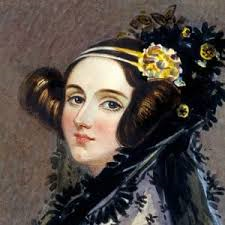There were 11 of us at Rita’s to find out about Ada Lovelace from Alison (who is interested in women written out of history or undervalued, as history is written by those in power). Ada Lovelace was born in 1815 into the aristocracy. Her mother was a Baroness who married Lord Bryon and Ada is his only legitimate child, Ada Byron. She never knew her father, who left the family when she was born, and died when she was eight. (She forgave him on her deathbed and is buried with him at Hucknell, Nottinghamshire). Her mother made sure she had an excellent education and that it was in Mathematics and Logic, avoiding Literature, as a defence against inheriting the poet’s madness – Ada was kept well away from poetry.
Ada was quite ill as a child, spending a lot of time alone. She was brought up largely by her grandmother and staff but her mother arranged the best tutors available, including Mary Summerfield (the Oxford College is named after her), and Charles Babbage (Cambridge Professor now known as Father of the computer, and if he is Father, Ada could certainly be called Mother – Babbage called her The Enchantress of Numbers). She shone in Maths and Metaphysics (theories about the unseen world around us). Babbage built an “infallible calculating machine” called The Difference Engine. Ada was involved in the project – she (and her mother ) went to factories to see the operation of Jacquard Looms, which weave a pattern into the cloth by using punched cards to steer the machine’s operation. Ada’s idea was to use similar cards to guide the Computer’s calculations. Punched cards were still being used in the 1970s. Ada often extended other people’s work, as in this case, adding, improving and recreating; she wrote lots of papers. She travelled abroad and helped Italian mathematician Menabrae to explain his Analytical Engine. Michael Faraday was interested in her work. She thought about Artificial Intelligence and ran ahead of everyone else. She worked out the first Algorithm that could be said to be a Computer.
Ada married at 19 to the Earl of Lovelace, and had three children, working on Maths in between. She had several affairs and died in 1852 at only 36, of cancer of the uterus. Alan Turing was fascinated by Ada. A machine to compose music started with Ada. She has a Blue Plaque in St James Square, London. There is a computer language called Ada, a Lovelace medal computer award, and an Ada Lovelace Day in mid-October to raise the profile of women in Computing. Thanks very much to Alison. It led to a discussion about why there were lots of women Programmers etc in the 1970s and 80s but now the industry is very much dominated by men – viz the recent misogynistic rant by a Google chap.
Article written by Kathy Ward [LO].
As a computer programmer for a large part of my early career after graduating in Archaeology from York, I was sorry to have missed this really interesting topic. I can attest to the lack of female computer programmers in the late 1980-90s from personal experience. I am still working for an IT company, although no-longer as a developer; the ratio of men to women is roughly the same on the software side. In fact, on the hardware side there are ZERO women that I have come across since my first job at Scunthorpe Borough Council, where the Operations Dept was entirely staffed by women! Julie Berry [member]![]()

